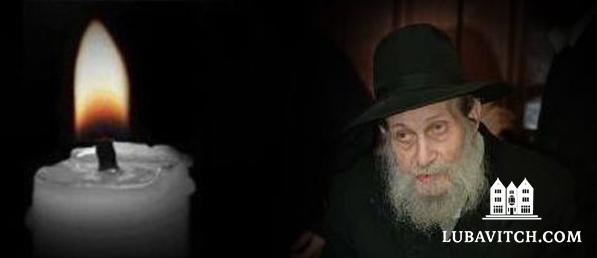(lubavitch.com) Rabbi Shamshon Charitonow, an expert on Chasidic melodies and a survivor of Soviet oppression, passed away last Thursday, Nov 26, in Brooklyn. He was 91 years old.
Born on October 12, 1918 in Nikolaev, Ukraine, Shamshon was the youngest of three children, and an only son. His father, Rabbi Sholom, was a ritual slaughterer and respected member of the Chasidic community.
Shamshon’s family was known to the greater Chabad community for their mastery of Chasidic niggunim, and he, too, learned the compositions of his father and uncles, as well as their technique, at an early age. By his bar-mitzvah, he had mastered many of the complex melodies passed down to him orally.
During Shamshon’s youth, Russia’s once flourishing Jewish communities were in flux, struggling to remain intact under the tides of change sweeping the nascent Soviet Union. While Mykolaiv remained host to giants of the Jewish community (Rabbi Meir Shlomo Yanovsky, the maternal grandfather of the seventh Lubavitcher Rebbe, Rabbi Menachem Mendel Schneerson, of blessed memory, served as chief rabbi of the town) both Communism and secularism had taken a heavy toll on the city’s youth. Shamshon, whose life reflected a deep commitment to Judaism, would later recall that it was rare to see an openly religious child in his town.
In 1933, the Charitonows moved north to Moscow, where Shamshon’s father hoped to better support his family. With his only son approaching yeshivah age, Sholom was concerned about the boy’s education, and consulted with Mrs. Sarah Katzenellenbogen, one of the industrious leaders of the Chasidic underground. Known affectionately in Yiddish as Mumme—or Auntie—Sarah, she suggested that Sholom send his son, then only 14 years old, to the yeshivah in Stararus where her own son was studying.
One year after Shamshon left home, his father died of illness. With communist authorities on his heels, Shamshon’s yeshiva days were tense. Where the Chabad yeshivas had once been centered in various large Chasidic communities such as those in Rostov on Don and Nevel, now, raids by the N.K.V.D.—the forerunners of the KGB—forced the yeshivas to go underground.
Shamshon fled from town to town, across Ukraine, evading police, harassment, and imprisonment. He and his fellow students met clandestinely in cellars and thus managed to continue their studies.
When the Germans invaded the Soviet Union in June of 1941, Shamshon fled with the others deep into the Russian interior to avoid the advancing Nazi war machine. Arriving in Uzbekistan, he managed to reunite with other Lubavitcher Chasidim in the cities of Tashkent and Samarkand, where, at a relatively safe distance from the watchful eye of the Kremlin, conditions for practicing Judaism were somewhat easier. Shamshon taught local Jewish children in Samarkand.
Although the Sixth Lubavitcher Rebbe, Rabbi Yosef Yitzchak Schneersohn, of blessed memory, had advised Shamshon to get a proper dispensation from the army, during the war all civilians were liable to be drafted. Despite his efforts to remain unnoticed, Shamshon was arrested for draft dodging and imprisoned.
Incarcerated during Passover with no matzah or kosher food, Shamshon survived the eight-day holiday almost solely on water rations. At the end of his prison time, he was given two choices—he would either be sent to the front lines—a certain death sentence at the time—or remain in jail. Shamshon chose the former. He was granted a few hours to prepare his belongings, and Shamshon’s friends used the chance to quickly smuggle him out of the city.
Hundreds of Chabad Chasidim, Shamshon among them, took advantage of the softening of Soviet policy at the war’s end. Under the guidance of legendary chasid, Rabbi Mendel Futerfas, and Rabbi Leib Mockin, and others, they managed to cross through the Ukrainian border town of Lviv in September of 1946.
Making his way to a DP camp in Brunoy, France, Shamshon settled temporarily in Paris. There he met and married his wife Shtzere Hadassah, his partner for the next sixty years. After the birth of their two eldest children, the family moved to the Crown Heights neighborhood of Brooklyn in 1956, so that they would live close to the Lubavitcher Rebbe.
Shamshon found work as a supervisor in a matzah bakery. But the music of his forebears lived on in his soul. Members of the community recall his unassuming personality and the Chasidic melodies he often hummed while at work.
At times, the Rebbe would ask Shamshon to sing during various farbrengens, once remarking that Shamshon’s rendition of Stav Ya Pitu, a complicated song in Ukrainian taught by the Rebbe in 1962, was performed exactly as the Rebbe had heard it. On another occasion, the Rebbe described Charitonow’s singing as “accurate to the sixteenth note.”
In the early 1970’s, Shamshon released his Negunei Shalom, a collection of chasidic melodies composed by his father.
Shamshon passed away on the Chasidic holiday of 9 Kislev, and is survived by his wife Shtzere Hadassah, and four sons: Yosef Yitzchok, Rabbi Sholom, a spiritual mentor in the Oholei Torah Talmudic Seminary in Crown Heights, Rabbi Shmaryahu, a Chabad Emissary in Buffalo, New York, and Rabbi Avraham, a consultant for Machne Israel.

Be the first to write a comment.